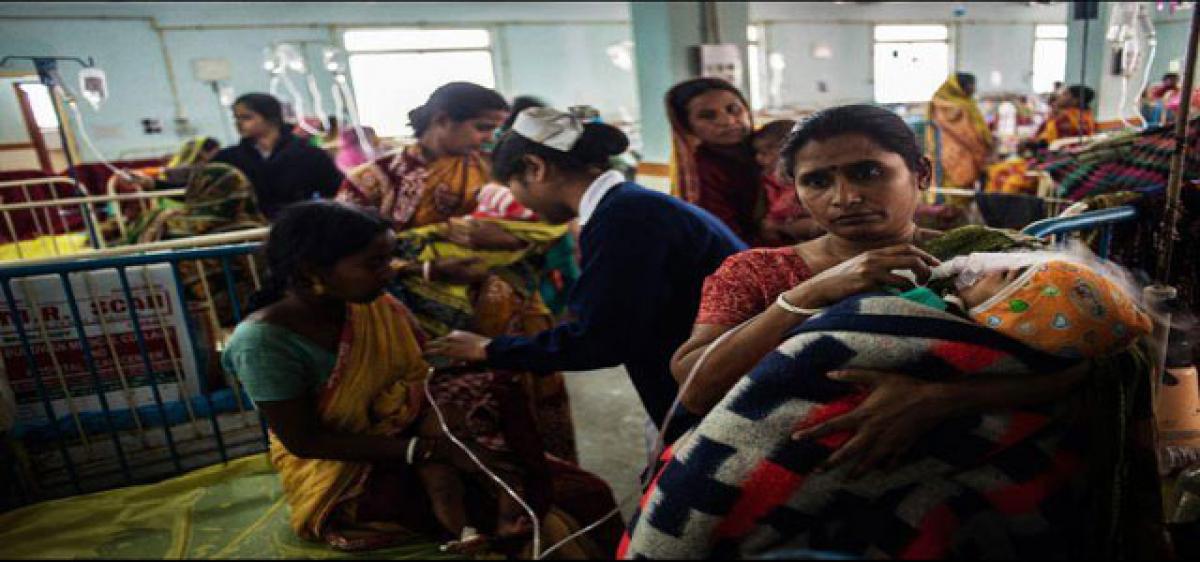Live
- Chanchalguda Jail Officials Say They Haven't Received Bail Papers Yet, Allu Arjun May Stay in Jail Tonight
- BJP leaders present evidence of illegal voters in Delhi, urge EC for swift action
- Exams will not be cancelled: BPSC chairman
- Nagesh Trophy: Karnataka, T.N win in Group A; Bihar, Rajasthan triumph in Group B
- YS Jagan condemns the arrest of Allu Arjun
- Economic and digital corridors to maritime connectivity, India and Italy building vision for future, says Italian Ambassador
- SMAT 2024: Patidar's heroics guide Madhya Pradesh to final after 13 years
- CCPA issues notices to 17 entities for violating direct selling rules
- Mamata expresses satisfaction over speedy conviction in minor girl rape-murder case
- Transparent Survey Process for Indiramma Housing Scheme Directed by District Collector
Just In
Rural women are increasingly accessing government hospitals


There was a 24 per cent rise in rural women accessing public healthcare between 2004 and 2014, according to a new report by Brookings India, a think tank, significant in a country where half the rural population uses private healthcare, which is four times costlier.
There was a 24 per cent rise in rural women accessing public healthcare between 2004 and 2014, according to a new report by Brookings India, a think tank, significant in a country where half the rural population uses private healthcare, which is four times costlier.
Overall, there was a six per cent rise in dependence on public healthcare for out-patients and seven per cent for in-patients over the decade ending 2014, said the Brookings report, which analysed National Sample Survey Office (NSSO) data over this period.
An in-patient is formally admitted for at least one night to a hospital, while an out-patient visits a hospital, clinic, or associated facility for diagnosis or treatment. For out-patient care, 74.9 per cent of ailing patients (who sought care) exclusively accessed a private facility in 2014, compared to 79.7 per cent in 2004.
The biggest decrease was seen among rural women, as we said. While 78.2 per cent of them sought private care in 2004, 70.4 per cent did in 2014. The percentage of in-patients seeking public care increased from 42.3 per cent in 2004 to 45.4 per cent in 2014; the percentage of rural women accessing public care rose from 45.1 per cent in 2004 to 56.1 per cent in 2014.
“The number of people seeking private healthcare, however, might be an underestimation, as NSSO surveyors are instructed to mark all those who went to both government and private facilities as 'only going to government facilities',” said the Brookings report. Indians spend eight times more in a private hospital than a government hospital, according to an analysis of National Health Accounts (NHA) 2013-14 data by The Hindu newspaper.
Despite the decline in exclusive dependence on private care, 29 of every 1,000 Indians pointed to the unsatisfactory quality of healthcare, the most commonly cited reason for not accessing a public hospital. Long waiting periods at government health services appears to be an increasing bottleneck in seeking public care. In 2004, 6.8 of every 1,000 cited this as a reason for not using a public hospital; it rose to 18.6 in 2014.
Of 930,000 doctors in India, 11.4 per cent (106,000) work for the government. This means there is one government doctor for every 11,528 people, according to the National Health Profile 2015. Public-health centres across India's rural areas 25,308 in 29 states and seven Union territories -- are short of more than 3,000 doctors, the scarcity rising 200 per cent (or tripling) over 10 years.
The number of people not using medical services fell from 15.1 in every 1,000 in 2004 to 12.4 in 2014, which implies an 18 per cent increase in Indians seeking some form of healthcare. There was an increase, however, in the proportion of people not seeking services, as they felt their ailment wasn't serious enough, and more women than men report not using healthcare due to the same reason the gender gap has widened over the decade.
More Indian men are likely to be admitted to hospital during the last moments of life than women 62.5 per cent to 37.5 per cent, as IndiaSpend reported. For every 1,000 men whose death is certified by medical professionals, the corresponding figure for women is 600. The number of people not using healthcare due to financial reasons reduced from four of every 1,000 in 2004 to 0.7 in 2014, said the Brookings report, possibly a result of rising incomes or use of publicly-funded health-insurance schemes implemented over the last 10 years by the central and state governments.
About 12 per cent of the urban and 13 per cent of the rural population got health insurance through the Rashtriya Swasthya Bima Yojana (National Health Insurance Scheme) or similar plans. By arrangement with IndiaSpend.org
By Devanik Saha

© 2024 Hyderabad Media House Limited/The Hans India. All rights reserved. Powered by hocalwire.com






